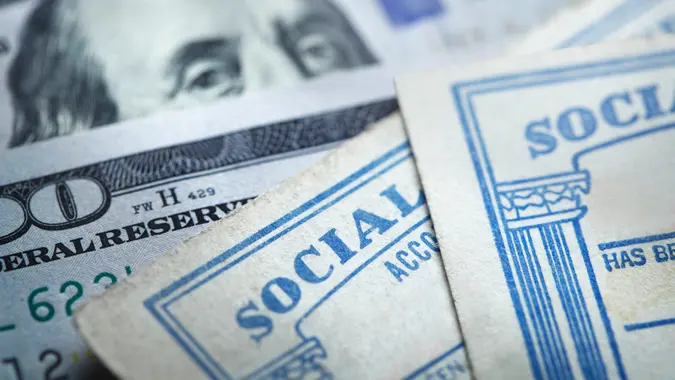7 Best (and Worst) Places To Retire If You Have No Savings

Commitment to Our Readers
GOBankingRates' editorial team is committed to bringing you unbiased reviews and information. We use data-driven methodologies to evaluate financial products and services - our reviews and ratings are not influenced by advertisers. You can read more about our editorial guidelines and our products and services review methodology.

20 Years
Helping You Live Richer

Reviewed
by Experts

Trusted by
Millions of Readers
Retirement planning can feel overwhelming, especially when you are trying to combat the skyrocketing cost of living with little to no savings in the bank. Does that mean a comfortable retirement is out of reach? Not necessarily.
If you’ll be relying primarily on Social Security benefits, choosing the right location is key. Some U.S. cities offer affordable housing and senior-friendly amenities, making them ideal for retirees with limited funds. Others, however, can drain your budget quickly due to high expenses or poor safety ratings. If you’re curious about which is where, GOBankingRates has rounded up a list.
Here’s a look at the best and worst places to retire with no savings, so you can make smarter decisions for your future.
7 Best Places To Retire Comfortably With No Savings
If you have been trying to figure out the best places to retire with no savings, keep in mind that affordability is key when planning retirement on a tight budget, and these cities make it possible. Plus, retirees can hang on to more of their income in these places because Social Security income isn’t taxed in any of these locations.
1. Mountain Home, Arkansas
- Percentage of retirement-aged people (65 and older): 29.9%
- Average home value: $237,393
- Property tax: 0.53%
- Annual grocery costs: $4,729.32
- Annual healthcare costs: $7,400.89
- Annual cost of utility bills: $4,164.87
- Annual transportation costs: $3,151.82
- Total annual cost of necessary expenditures: $19,446.91
2. Hot Springs Village, Arkansas
- Percentage of retirement-aged people (65 and older): 59.9%
- Average home value: $303,006
- Property tax: 0.53%
- Annual grocery costs: $4,873.54
- Annual healthcare costs: $7,705.92
- Annual cost of utility bills: $4,113.19
- Annual transportation costs: $4,421.17
- Total annual cost of necessary expenditures: $21,113.82
3. Bella Vista, Arkansas
- Percentage of retirement-aged people (65 and older): 31.9%
- Average home value: $354,350
- Property tax: 0.53%
- Annual grocery costs: $4,848.68
- Annual healthcare costs: $7,376.81
- Annual cost of utility bills: $4,078.73
- Annual transportation costs: $4,670.25
- Total annual cost of necessary expenditures: $20,974.47
4. The Villages, Florida
- Percentage of retirement-aged people (65 and older): 85.2%
- Average home value: $404,820
- Property tax: 0.74%
- Annual grocery costs: $5,077.43
- Annual healthcare costs: $7,858.43
- Annual cost of utility bills: $4,530.96
- Annual transportation costs: $4,033.18
- Total annual cost of necessary expenditures: $21,500.01
5. Green Valley, Arizona
- Percentage of retirement-aged people (65 and older): 79.8%
- Average home value: $316,970
- Property tax: 0.44%
- Annual grocery costs: $4,774.08
- Annual healthcare costs: $6,855.06
- Annual cost of utility bills: $4,406.06
- Annual transportation costs: $4,373.27
- Total annual cost of necessary expenditures: $20,408.47
6. Foley, Alabama
- Percentage of retirement-aged people (65 and older): 32.5%
- Average home value: $315,409
- Property tax: 0.36%
- Annual grocery costs: $4,784.03
- Annual healthcare costs: $9,271.19
- Annual cost of utility bills: $4,238.09
- Annual transportation costs: $3,367.37
- Total annual cost of necessary expenditures: $21,660.67
7. Punta Gorda, Florida
- Percentage of retirement-aged people (65 and older): 53.5%
- Average home value: $390,656
- Property tax: 0.74%
- Annual grocery costs: $5,375.81
- Annual healthcare costs: $7,681.84
- Annual cost of utility bills: $4,186.40
- Annual transportation costs: $3,932.59
- Total annual cost of necessary expenditures: $21,176.65
7 Worst Places To Retire With No Savings
Now comes the time to analyze a list of places to avoid, even if they happen to be popular retirement destinations. Because of this popularity, you’ll find much higher prices in the housing market as well as the cost of living in general, which is not ideal if you don’t have any savings. While none of these cities tax Social Security benefits, most of them do tax retirement income.
Additionally, the safety in these cities varies wildly, and the annual costs of services and expenditures remain on the high end.
1. Burr Ridge, Illinois
- Percentage of retirement-aged people (65 and older): 35.8%
- Average home value: $905,478
- Property tax: 1.83%
- Annual grocery costs: $5,022.73
- Annual healthcare costs: $7,577.49
- Annual cost of utility bills: $4,216.55
- Annual transportation costs: $5,939.60
- Total annual cost of necessary expenditures: $22,756.37
2. Sonoma, California
- Percentage of retirement-aged people (65 and older): 32.6%
- Average home value: $1,021,522
- Property tax: 0.70%
- Annual grocery costs: $5,520.03
- Annual healthcare costs: $8,942.08
- Annual cost of utility bills: $4,457.75
- Annual transportation costs: $5,201.94
- Total annual cost of necessary expenditures: $24,121.79
3. Ocean City, New Jersey
- Percentage of retirement-aged people (65 and older): 34.2%
- Average home value: $1,428,637
- Property tax: 1.77%
- Annual grocery costs: $5,679.17
- Annual healthcare costs: $7,818.30
- Annual cost of utility bills: $4,815.23
- Annual transportation costs: $4,675.04
- Total annual cost of necessary expenditures: $22,987.73
4. Paradise Valley, Arizona
- Percentage of retirement-aged people (65 and older): 30.9%
- Average home value: $3,282,164
- Property tax: 0.44%
- Annual grocery costs: $5,679.17
- Annual healthcare costs: $7,424.98
- Annual cost of utility bills: $4,367.30
- Annual transportation costs: $5,340.85
- Total annual cost of necessary expenditures: $22,812.29
5. Ridge, New York
- Percentage of retirement-aged people (65 and older): 34.5%
- Average home value: $561,406
- Property tax: 1.26%
- Annual grocery costs: $5,191.81
- Annual healthcare costs: $10,049.80
- Annual cost of utility bills: $5,357.91
- Annual transportation costs: $5,331.27
- Total annual cost of necessary expenditures: $25,930.79
6. Pacific Grove, California
- Percentage of retirement-aged people (65 and older): 28.9%
- Average home value: $1,407,180
- Property tax: 0.70%
- Annual grocery costs: $5,564.79
- Annual healthcare costs: $11,534.80
- Annual cost of utility bills: $3,738.48
- Annual transportation costs: $4,732.52
- Total annual cost of necessary expenditures: $25,570.58
7. Walnut Creek, California
- Percentage of retirement-aged people (65 and older): 29%
- Average home value: $1,375,704
- Property tax: 0.70%
- Annual grocery costs: $5,569.76
- Annual healthcare costs: $9,720.70
- Annual cost of utility bills: $4,418.98
- Annual transportation costs: $6,107.25
- Total annual cost of necessary expenditures: $25,816.69
Methodology: For this piece, GOBankingRates first found the 100 towns or cities with the (1) highest percentage of the population aged 65 years and older, as sourced from the U.S. Census Bureau 2023 American Community Survey. GOBankingRates analyzed those 100 cities across the following factors: (2) property tax as sourced from Tax Foundation 2024 data; (3) the average 2025 home value for a single-family residence as sourced from Zillow’s September 2025 data. GOBankingRates then took the Bureau of Labor Statistics Consumer Expenditure Survey’s 2023 annual expenditures for consumers 65 years and older for Groceries (“food at home”), Healthcare, Utilities (“utilities, fuels and public services”), and Transportation (gas, other fuels & motor oils” + ” other vehicle expenses”). These annual expenditures were then factored out for each city using Sperling’s Best Places Cost of Living Indices and combined to give a (4) total annual Cost of Living Expenditure for each city; (5) taxes on Social Security benefits; and (6) The annual cost of an adult day health care service on the state level, (7) the annual cost of homemaker services on the state level, and (8) the annual cost of a home health aide on the state level were all sourced from Genworth’s annual Cost of Care Survey. These eight factors were then compiled and scored, with a lower score being better. In final calculations, annual expenditure scores were weighted 3x, home value scores were weighted 2x, and taxes on Social Security were weighted 0.5x. All research was conducted and up to date on November 5, 2025.
 Written by
Written by  Edited by
Edited by 
























